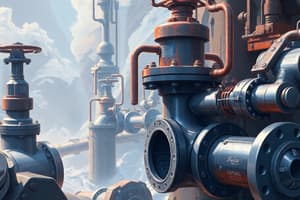Podcast
Questions and Answers
What is a common feature of spur gears?
What is a common feature of spur gears?
- Teeth cut on a helix pattern
- Screw-shaped
- Simple straight teeth meshed directly onto cylinders (correct)
- Conical shaped
Which gear type is known for providing smoother operation and quieter noise compared to spur gears?
Which gear type is known for providing smoother operation and quieter noise compared to spur gears?
- Worm Gears
- Bevel Gears
- Spur Gears
- Helical Gears (correct)
How do crank and slide systems produce a linear force?
How do crank and slide systems produce a linear force?
- By rotating around their axis
- By providing smooth rolling motion
- Adding more strands of rope or chains
- By using a circular motion (correct)
What is the primary function of idlers and racks in gear systems?
What is the primary function of idlers and racks in gear systems?
In cam and follower systems, what is the purpose of the follower mechanism?
In cam and follower systems, what is the purpose of the follower mechanism?
What is a lever?
What is a lever?
Which of the following is NOT a simple mechanism?
Which of the following is NOT a simple mechanism?
What does mechanical advantage refer to?
What does mechanical advantage refer to?
In a gear system, what is responsible for transferring motion between gears?
In a gear system, what is responsible for transferring motion between gears?
What is the main function of a cam and follower system?
What is the main function of a cam and follower system?
Flashcards
Simple Mechanism
Simple Mechanism
A basic device that converts one type of motion to another, like a lever, wheel, or pulley.
Complex Mechanism
Complex Mechanism
A device with multiple parts working together to perform a task, like a clock or a robot.
Mechanical Advantage
Mechanical Advantage
A measure of how much a machine multiplies force or reduces the necessary input force.
Lever System
Lever System
Signup and view all the flashcards
Pulley System
Pulley System
Signup and view all the flashcards
Gear System
Gear System
Signup and view all the flashcards
Spur Gear
Spur Gear
Signup and view all the flashcards
Bevel Gears
Bevel Gears
Signup and view all the flashcards
Cam and Follower
Cam and Follower
Signup and view all the flashcards
Rotating Cylinder Cam
Rotating Cylinder Cam
Signup and view all the flashcards
Study Notes
Mechanisms are essential components in everyday life and engineering. They enable movement or alterations in physical form through the application of force. These devices can be found everywhere from tiny microchips to heavy machinery on construction sites. Let's explore some key aspects of mechanisms, including different types, mechanical advantage, and specific systems like gears and cams.
Types of Mechanisms
There are various ways to categorize mechanisms based on their function and design:
-
Simple Mechanisms: These are basic elements used to convert one type of motion into another, such as levers, wheels, pulleys, and wedges.
- Levers: A simple mechanism where a bar is supported at one end by a fixed pivot point and rotated around this point, causing the other end to rise or fall relative to its starting position.
- Wheels and Pulleys: Similar to levers, these allow movement along a linear path to be converted to rotational movement or vice versa.
- Wedges: A triangular object with two flat sides that fits into a gap and exerts pressure on it, often used to split objects apart.
-
Complex Mechanisms: These involve multiple parts working together to perform a task, such as clocks, automobiles, and robots. For instance, gears and cams are complex mechanisms that require coordination between many components.
Mechanical Advantage
Mechanical advantage refers to the ratio of output force to input force required for a device to move an object. It improves efficiency by reducing the force needed to lift or push something heavier. There are several methods to achieve mechanical advantage:
- Lever Systems: By using a lever, you can multiply your force by moving an arm across a fulcrum. This principle underlies many machines and tools we use daily.
- Pulley System: Adding more strands of rope or chains to a system can increase the number of times an object needs to travel before reaching the top, thus reducing the force needed to raise it.
- Crank and Slide System: Cranks are a special kind of lever that uses a circular motion to produce a linear force, commonly seen in bicycles and power tools.
- Wheel and Axle System: A wheel attached to a shaft provides smooth rolling motion and increases the force applied to a load.
Gear Systems
Gear systems consist of two or more interlocking gears designed to transmit torque and change speed or direction. They're common in vehicles, machines, and toys. The primary types of gears are:
- Spur Gears: Simple straight teeth meshed directly onto cylinders.
- Bevel Gears: Conical shaped, angled teeth used when axes of rotation are non-parallel.
- Helical Gears: Teeth cut on a helix pattern that mesh at an angle, providing smoother operation and quieter noise compared to spur gears.
- Worm Gears: Screw-shaped gear used for high reduction ratios; it generally has better durability and higher torque capacity than other types of gears.
Many gear systems also incorporate idlers and racks to amplify or reduce the rotational speed during transmission.
Cam and Follower Systems
Cam and follower systems work by converting continuous rotation into oscillatory motion. Cams are curved surfaces with raised areas called lobes, grooves, or flutes which control follower movements. Examples of cams include:
- Rotating Cylinder Cams: Rotate around their axis to produce linear motion.
- Sectoral Cams: Have smaller arcs of circle defined by sector lines and produce simpler motions.
- Composite Cams: Combine features of multiple types of cams for complex motions.
Follower mechanisms follow the contour of the cam surface, producing oscillatory motion. Various designs exist depending on the desired motion profile, including followers with rollers, slides, rockers, or hydraulic or pneumatic actuators.
In conclusion, mechanisms play a crucial role in our lives, whether they're small enough to fit within a computer chip or large enough to move massive industrial loads. Understanding the principles behind them—such as mechanical advantage and how complex combinations of simple mechanisms work—can help us appreciate the world around us just a bit more.
Studying That Suits You
Use AI to generate personalized quizzes and flashcards to suit your learning preferences.




